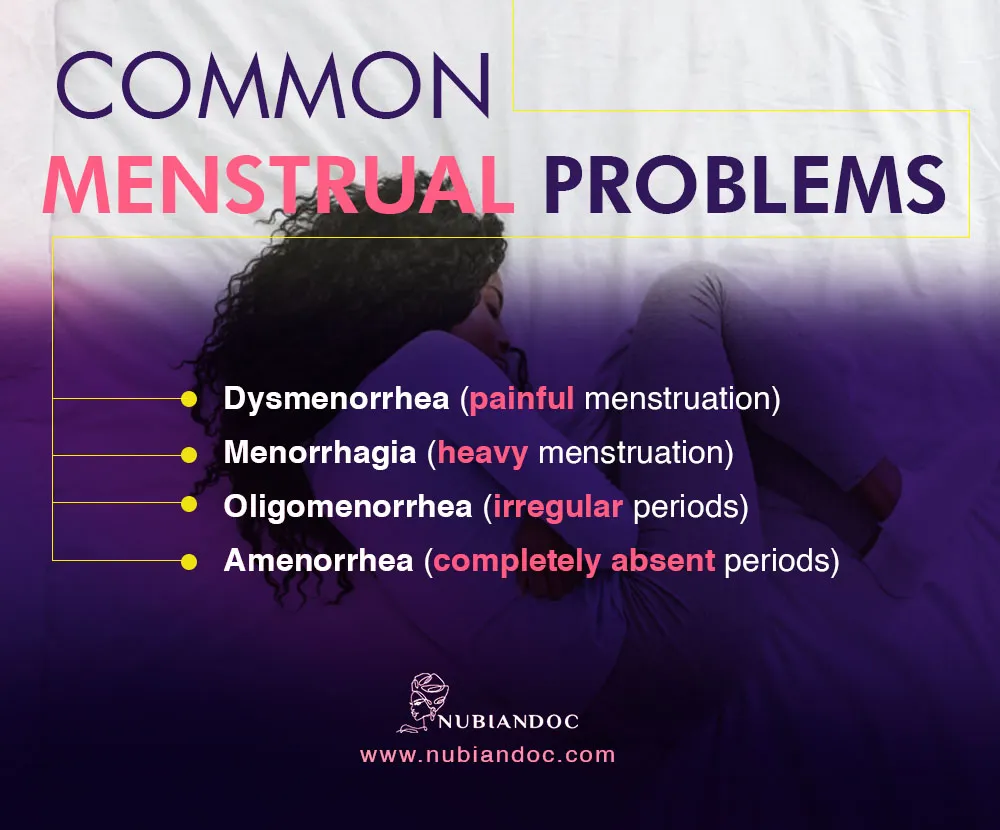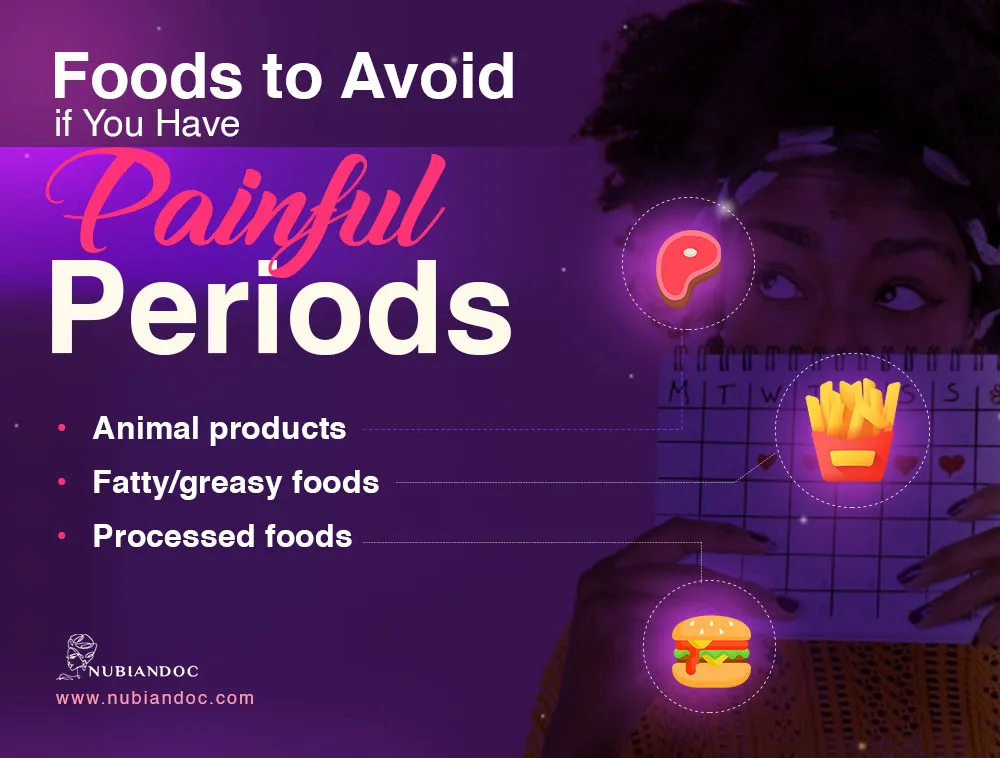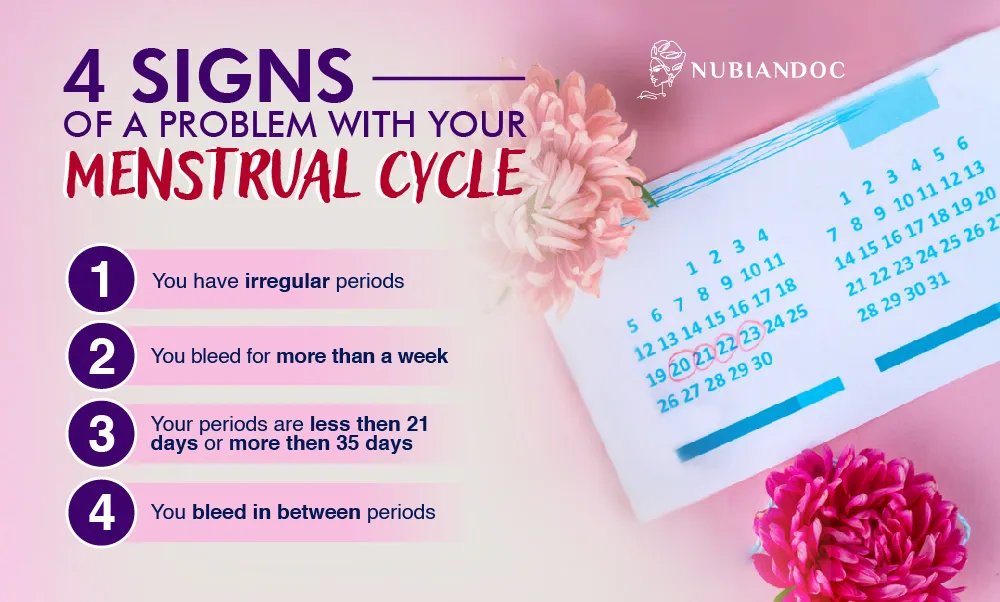Menstruation: What Your Period Says About Your Health?
Menstruation | Symptoms | Menstruation cycle | Healthy foods to eat | Foods to avoid during periods | Menstrual hygiene management
What Is Menstruation?
Menstruation is defined as the monthly shedding of the inner lining of a woman’s uterus. Menstruation is also known by such terminology as menses, menstrual period, just “your period” or more colloquially in conversations as “aunt flow”. The menstrual contents (a mixture of partly blood and partly the uterus tissues) exit the uterus and flow out of the body through the vagina.
There is a broad range in puberty onset among both boys and girls. Although the average age of first menstruation (menarche) is 12-13 years old in the US, menstruation can start as early as 9 years of age or as late as 18 years globally and varying between race and ethnicity. Timing of menarche onset appears to be correlated with nutritional and health factors. A young female’s development tends to follow a pattern signaling menarche onset but those indicators are not completely exclusive. Those include increased linear growth, breast development, underarm and pubic hair growth, and the maturation of the adrenal glands that produce androgen hormones.
- By and large, a female starts menstruating 2 years after her breasts starts to develop
- About 6 months to a year before a girl starts menstruating, she might see mucous like vaginal discharge on her panties
How Exactly Does Menstruation Occur?
Your period happens primarily through hormonal changes. Hormones are chemical messengers that carry information through the blood stream to a target organ. The ovaries release two important hormones, estrogen and progesterone. These hormones are involved in the thickening of the endometrium, the innermost layer of the uterus that faces its inner cavity. This built up endometrium provides the optimal environment for implantation of a fertilized egg. If the egg is not fertilized, implantation does not occur and the endometrium breaks down and sheds, leading to menses. This process will repeat multiple times over the course of a woman’s reproductive lifespan.
What are the Most Common Menstrual Problems?
Some common problems associated with the menstrual cycle are as follows:

Dysmenorrhea
- Painful menstruation may be related to just repeat pain associated with your period or an infection, fibroids (benign tumor the uterus), adenomyosis ( a condition where the lning of the uteus grows into the muscular causing the uterus to appear much bigger than normal), or endometriosis (when tissue from the endometrium migrates and relocates outside of the uterus). Dysmenorrhea may also be related to an ectopic pregnancy in more serious cases.
Menorrhagia
- Abnormal heavy or prolonged bleeding (>7 days) may be described as frequent sanitary or tampon changes, and/or blood clots larger than a quarter in diameter. A potential cause may include ovarian dysfunction, pregnancy, uterine fibroids, polyps, certain medical conditions, or medications. Women should see their doctor if they have bleeding such that they ae changing a soaked thru pad or tampon every hour for more than two hours.
Oligomenorrhea
- Oligomenorhea is a change in frequency of periods where cycles are greater than 35 days. This may be seen frequently in adolescents as a result of an immature hypothalamic -pituitary-ovarian axis or may be related to abnormal body habitus, low calorie/low nutritional status, polycystic ovarian syndrome (pcos), metabolic disorders (such as diabetes, hypo or hyper- thyroidism) or may be the initial indicator for perimenopause (the transition period prior to menopause, when a woman’s periods cease).
Amenorrhea
- Amenorrhea, the absence of menses, may be transient were a single period is missed, intermittent or permanent. Commonly in women older than 15 years of age the cause is related to pregnancy. Other causes can include stressors such as a recent illness or significant psychosocial pressures. If a woman has had a missed period for at least 3 months after having normal periods it should be a concern to see your doctor for further consultation. Other potential causes of amenorrhea can include being on birth control (such as depo povera or an intrauterine IUD), breastfeeding, premature ovarian failure, menopause, hypothyroidism, hyperprolactinemia, PCOS, or a congenital or genetic cause.
What is Premenstrual Syndrome?
As the name suggests, Premenstrual Syndrome (PMS) refers to occurance of a combination of symptoms, physical and/or nonphysical at least 5 days before a women’s menstrual cycle. This may include bloating, breast pain, mood swings, fatigue and/or headaches and is to a severe degree that is associated with “economic or social dysfunction” as defined by the American College of Obstetricians and Gynecologists (ACOG). PMS typically defined by being present in at least 3 consecutive menstrual cycles. The treatment for mild symptoms can include exercise, stress reduction measures and potential starting an oral contraceptive (birth control medication). For more moderate to severe cases there may be more options such as selective serotonin reuptake inhibitors (SSRIs) that may be considered after consultation with your doctor.
What are Common Symptoms of Menstruation?
Symptoms of Menstruation
Many women experience mild to moderate symptoms during menstruation. Symptoms may change over time. However, here are some of the most common physical symptoms associated:
- Abdominal cramps
- Muscle aches
- Tender breasts
- Bloating and fluid retention
- Fatigue before and/or during your period
- Lower back pain
- Low energy and performance etc.
Normal discomfort and mild symptoms attributed to menstruation are manageable enough that they typically don’t affect routine daily activities. But for some girls early in their reproductive life, symptoms may be more significant without a definable cause.
Nubian Doc’s 8-week health plan offers easy to follow exercise plans and healthy yet scrumptious recipes to stay fit and maintain overall wellbeing.
Summary: Years between puberty and menopause, a woman’s body undergoes a sequence of cyclic events each month to make it ready for reproduction. In case pregnancy does not occur, the uterine lining degenerates and menses occurs. Symptoms associated with menstruation include muscle aches, tender breasts, headaches and low energy etc.
That time of the month can certainly be annoying at times but it can sometimes reveal important things about a woman’s health. When your periods are heaviest, bleeding will appear red but you may notice on other days that it is brownish or dark. This is blood undergoing a process called oxidation – a color change due to exposure to oxygen. Anything out of the norm such as greyish discharge during your period could signal an anomaly such as an infection. Especially if you also notice an odor, itching, discomfort, pelvic pain or a fever. Any combination of these findings should alert you to see your doctor for an evaluation.
Anything outside of your normal period pattern whether it is heavier cycle(s), missed or (a) prolonged periods may be an issue of concern for possible infection, pregnancy, or a health condition like as PCOS or fibroids, and should initiate seeing your doctor.
What is a Normal Menstrual Cycle?
First of all your menstrual cycle is defined as the sequence of events that a female’s body goes through as it prepares for pregnancy. Nature and evolution have primed our bodies for reproduction which is an adaptation that all organisms require to exist. Your menstrual cycle begins from the first day of menstruation, when you start bleeding, up to the last day before your next menstrual period begins. The average cycle is 28 days long. However, a cycle, as short as 21 days or as long as 35 days is considered normal. A normal cycle can have any cycle length within that spectrum but should be relatively consistent. A consistent cycle pattern is the number one sign that a woman is fertile or ovulating. That typically also means a woman of has normal hormone levels and is more likely than a women with abnormal or irregular periods to get pregnant if trying to conceive.
The phases of menstrual cycle are triggered by the changes in the levels of different hormones. The major events that happen during an entire menstrual cycle are explained here:
The Menstrual Phase
If a women’s ovum (egg) that is released from her ovary has not been fertilized this phase occurs whereby the endometrium (inner lining of the uterus) sheds and menstrual bleeding commences. It usually lasts from day one to five. Most women bleed for three to five days. However, periods length can vary from two to seven days.
The Follicular Phase
Follicular phase usually starts from day six till day fourteen or so. During this phase, estrogen level rises which helps endometrium to grow and thicken. Along with this, follicle stimulating hormone (FSH) help follicles to grow and by day 14, one of the follicles matures into a fully developed ovum.
Ovulation
Ovulation is defined as the release of the ovum from the surface of the ovary. This occurs roughly at 14th day (mid-cycle) of a 28 day menstrual cycle. The rising levels of estrogen lead to the release of Gonadotropin releasing hormone in our brain. This hormone will thereby stimulate the pituitary gland to release increased levels of luteinizing hormone (LH) and FSH.
The release of the ovum is triggered by the increased levels of LH. The ovum is released into the fallopian tube, which functions solely as a transport system for the egg to make its way to the uterus. It contains cilia that sweep the egg into the tube and towards the uterus. Viability of a typical ovum is just about 24 hours. If it is not fertilized by sperm, it will be reabsorbed by the body.
Luteal Phase
After the ovum is released from its follicle during ovulation, the ruptured follicle remains on the surface of the ovary and for the next 14 days, it changes into a structure called “corpus luteum”. This helps release progesterone and small amounts of estrogen to maintain the thickened endometrium for the fertilized ovum to adhere.
If the ovum is not fertilized, the corpus luteum wilts and dies at usually at around 22nd of 28 days menstrual cycle. This causes the drop in progesterone level which makes uterine wall to shed away. The cycle then repeats all over again.
Summary: When menstrual period begins, levels of estrogen, progesterone and some other hormones fluctuate to make the body ready for reproduction and possible pregnancy. If the ovum is not fertilized, the cycle will repeat.

Why Does Period Bloating and Water Retention Occur?
The simplest answer is “hormones”. In the luteal phase of the menstrual cycle, progesterone and estrogen levels fluctuate, the increase in the levels of progesterone can stimulate the production of a hormone aldosterone, which makes the kidneys retain water and salt. It may be counter intuitive but drink more water during menstruation to prevent dehydration and help with fluid retention.
Our e-book has it all ranging from 8 weeks health plan to weekly grocery list to sort it out for you in order to stay healthy.
Healthy Foods to Eat During Periods
In general, a diet that is low in processed foods and high in fiber, plant-based foods is generally recommended for overall health and to decrease the risk of many chronic conditions that cause dis-ease and mortality across the world. It is a broad recommendation that many of us physicians support. Eating foods that are more anti-inflammatory and that decrease inflammation n the body may help for particularly those patient that have significant menstrual cramps. These foods include fruits, vegetables, whole grains, nuts, legumes. We know that it is large amounts of inflammatory prostaglandins released by endometrial cells during their breakdown associated with menstruation. These prostaglandins are what also cause uterine blood vessels to constrict and the muscle layer of the uterus to contract leading to the menstrual cramping that some women experience. NSAIDs such as motrin and midol are often recommended by doctors to help reduce the production of these prostaglandins. Foods that reduce inflammation can also help reduce menstrual cramps.
At Nubian Doc, we have a blog post dedicated to the benefits of this super food, Read Ginger: interesting facts and health benefits of the medicinal food.
Summary: Some foods can help alleviate the symptoms associated with menstruation such as menstrual cramps, headaches, muscle aches etc. These comfort foods include ginger, yogurt, salmon, healthy fats and water. A dip in iron levels can be restored by consuming leafy green vegetables, oatmeal etc.

Do I need to Avoid Any Foods During Periods?
For women that have significant menstrual cramps consider not only adding more whole plant based-fiber rich foods to your diet but decreasing or eliminating animal products and processed foods that do not contain fiber. For significant issues with bloating or water retention consider avoiding caffeine and alcohol consumption during your period.
Menstrual Hygiene Management
Menstrual hygiene management encompasses access to hygiene products to collect menstrual flow, privacy to change hygiene products and, access to facilities to dispose of used materials. It also includes other systemic factors that associate menstruation with overall well-being, gender equality, women’s education, and empowerment. There’s a huge barrier to menstrual hygiene management for girls living in developing countries where clean water and other sanitary facilities are inadequate. In those settings menstruation can act as a barrier to education because lack of sanitary products limits involvement in educational and many social activities.
| Let’s Debunk the Myths about Periods | |
| Myth | Fact |
| Girls should not visit sacred places or cook during periods | Periods are not impure, it’s just nature’s way of telling you are growing up normally |
| Purchasing sanitary products should be kept private | Buying sanitary products is just like buying shampoo or soap, there’s no need to hide sanitary products |
| During periods, girls should not go near plants or touch flowers, they will die | Going near plants during your period will not make them wither |
| You can’t get pregnant during your period | Your risk of getting pregnant is low but still possible |
| Don’t wash your hair | You’ll be just fine washing your hair during your period |
Bottom Line: Menstruation
The menstrual cycle is complex and well adapted evolutionary process involving different glands, organs and chemical messengers. There are many things that you can learn to know what’s normal and what may be a cause for concern as discussed in this article.
Nubian Doc is working exclusively to disseminate health and nutrition education through its educational blogs. Give our blogs a read now. Also for any health related queries or for booking an online consultation, you may contact us now.



